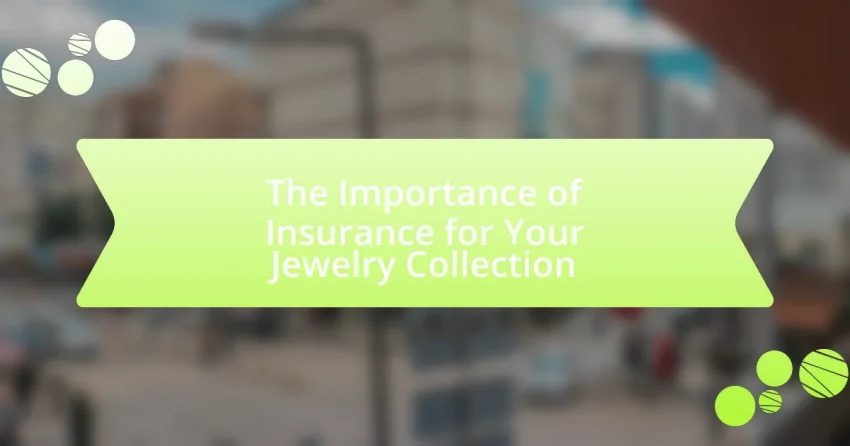Insurance for jewelry collections is essential for providing financial protection against loss, theft, or damage, as jewelry often represents a significant investment. The article outlines the various risks associated with unprotected jewelry, including the financial burden of replacing stolen or damaged items and the emotional distress that accompanies such losses. It discusses the types of coverage available, the importance of accurate appraisals, and the factors influencing insurance costs. Additionally, the article emphasizes best practices for managing jewelry insurance policies, including regular reviews and updates to ensure adequate protection. Understanding these aspects is crucial for jewelry owners to safeguard their valuable collections effectively.

Why is Insurance Important for Your Jewelry Collection?
Insurance is important for your jewelry collection because it provides financial protection against loss, theft, or damage. Jewelry can be a significant investment, with high-value pieces often costing thousands of dollars. Without insurance, the financial burden of replacing or repairing lost or damaged items falls entirely on the owner. According to the Insurance Information Institute, approximately 1 in 10 households experiences a property crime each year, highlighting the risk of theft. Additionally, jewelry insurance can cover the costs of appraisal and restoration, ensuring that your collection retains its value over time.
What risks does a jewelry collection face without insurance?
A jewelry collection without insurance faces significant risks including theft, loss, and damage. Without insurance, the owner bears the full financial burden of replacing or repairing valuable pieces, which can amount to thousands of dollars. For instance, the FBI reported that jewelry thefts accounted for approximately $1 billion in losses annually in the United States, highlighting the prevalence of such risks. Additionally, natural disasters or accidents can lead to irreparable damage, further emphasizing the need for protection. Therefore, the absence of insurance exposes the collection to substantial financial loss and emotional distress.
How can theft impact the value of your jewelry collection?
Theft can significantly decrease the value of your jewelry collection by removing items that contribute to its overall worth. When jewelry is stolen, not only is the monetary value lost, but the emotional and historical significance attached to those pieces is also irretrievably gone. According to the Insurance Information Institute, jewelry theft accounts for a substantial portion of property crime, with losses averaging thousands of dollars per incident. This loss can lead to a diminished collection value, as the remaining pieces may not hold the same appeal or market demand without the stolen items. Additionally, the lack of insurance coverage for stolen jewelry can result in financial hardship, as owners may not be able to recover the full value of their collection.
What are the potential damages that can occur to jewelry?
Potential damages to jewelry include physical damage, such as scratches, dents, or breaks, as well as loss or theft. Physical damage can occur from everyday wear, improper storage, or exposure to harsh chemicals, which can weaken materials. Loss or theft can happen due to accidents, misplacement, or criminal activity. According to the Jewelers Mutual Insurance Company, approximately 1 in 3 jewelry owners will experience a loss or theft in their lifetime, highlighting the importance of insurance to protect against these potential damages.
How does insurance protect your jewelry collection?
Insurance protects your jewelry collection by providing financial compensation in the event of loss, theft, or damage. This coverage ensures that you can replace or repair your valuable items without incurring significant out-of-pocket expenses. For instance, specialized jewelry insurance policies often cover the full appraised value of the pieces, which can be crucial given that jewelry can appreciate over time. According to the Insurance Information Institute, having dedicated jewelry insurance can help mitigate the financial impact of unforeseen events, allowing collectors to maintain their collections without substantial financial strain.
What types of coverage are available for jewelry insurance?
Jewelry insurance typically offers several types of coverage, including all-risk coverage, which protects against loss, theft, and damage; and specific peril coverage, which covers only certain risks like theft or fire. All-risk coverage is comprehensive and often recommended for valuable collections, as it provides broader protection. Specific peril coverage may be more affordable but limits the types of incidents covered. According to the Insurance Information Institute, jewelry insurance can also include coverage for accidental loss, mysterious disappearance, and even coverage for repairs or restoration, ensuring that policyholders are adequately protected against various risks associated with their jewelry.
How does replacement value differ from actual cash value in jewelry insurance?
Replacement value in jewelry insurance refers to the amount needed to replace a lost or damaged item with a new one of similar kind and quality, while actual cash value is the replacement cost minus depreciation, reflecting the item’s current market value. For example, if a piece of jewelry originally valued at $5,000 is lost, the replacement value would cover the full cost to buy a new equivalent piece, whereas the actual cash value might only provide $3,500 due to depreciation over time. This distinction is crucial for policyholders to understand, as it directly impacts the financial recovery in the event of a loss.

What should you consider when insuring your jewelry collection?
When insuring your jewelry collection, you should consider the value of the items, the type of coverage, and the specific risks associated with jewelry ownership. Accurately appraising the value of each piece is crucial, as insurance typically covers the replacement cost, which can vary significantly based on market conditions and the item’s unique characteristics. Additionally, you should evaluate whether to choose a policy that covers loss, theft, and damage, as well as whether it includes worldwide coverage or specific exclusions. Understanding the risks, such as theft or accidental damage, can help tailor your insurance policy to adequately protect your collection.
How do you determine the value of your jewelry for insurance purposes?
To determine the value of your jewelry for insurance purposes, you should obtain a professional appraisal from a certified gemologist or appraiser. This appraisal will assess the jewelry’s quality, materials, and market value, providing a documented value that insurers typically require. According to the American Society of Appraisers, a qualified appraiser will consider factors such as the type of metal, gemstones, craftsmanship, and current market trends to establish an accurate value. This process ensures that your jewelry is adequately covered in case of loss or damage, reflecting its true worth in the current market.
What methods can be used to appraise jewelry accurately?
To appraise jewelry accurately, professional appraisers typically use methods such as gemological analysis, comparative market analysis, and historical sales data evaluation. Gemological analysis involves examining the jewelry’s materials, including gemstones and metals, using tools like microscopes and refractometers to determine quality and authenticity. Comparative market analysis assesses similar items’ selling prices in the current market, providing a benchmark for valuation. Historical sales data evaluation looks at past auction results and sales records to gauge the item’s worth based on trends and demand. These methods ensure a comprehensive and precise appraisal, reflecting the jewelry’s true value in the market.
Why is it important to keep updated appraisals for your jewelry?
Keeping updated appraisals for your jewelry is crucial for ensuring accurate insurance coverage and financial protection. Jewelry values can fluctuate due to market changes, economic conditions, and trends, making it essential to have current appraisals that reflect the true worth of your pieces. For instance, a study by the Gemological Institute of America indicates that jewelry values can change significantly over time, sometimes by as much as 20% annually. This means that an outdated appraisal could lead to insufficient coverage in the event of loss or theft, resulting in financial loss. Therefore, regular updates to appraisals help maintain adequate insurance protection and ensure that you are compensated fairly in case of a claim.
What factors influence the cost of jewelry insurance?
The cost of jewelry insurance is influenced by several key factors, including the value of the jewelry, the type of coverage selected, the location of the insured, and the deductible amount. Higher-value jewelry typically results in higher premiums, as the potential loss is greater. The type of coverage, whether it is actual cash value or replacement cost, also affects the cost; replacement cost coverage generally incurs higher premiums. Additionally, the location can impact rates due to varying theft and loss rates in different areas. Lastly, choosing a higher deductible can lower the premium, while a lower deductible increases it. These factors collectively determine the overall cost of insuring jewelry.
How does the type of jewelry affect insurance premiums?
The type of jewelry significantly affects insurance premiums due to variations in value, material, and risk factors associated with different pieces. High-value items, such as diamond rings or antique jewelry, typically incur higher premiums because they represent a greater financial risk to insurers. Additionally, jewelry made from precious metals or featuring rare gemstones may also lead to increased costs, as these materials are more expensive to replace. According to the Insurance Information Institute, the average cost of insuring jewelry can range from 1% to 2% of its value annually, indicating that more valuable pieces will proportionately increase insurance costs.
What role does the location of the insured play in determining costs?
The location of the insured significantly influences insurance costs due to varying risk factors associated with different geographical areas. For instance, areas with higher crime rates typically result in increased premiums because the likelihood of theft or loss is greater. Additionally, regions prone to natural disasters, such as floods or earthquakes, also lead to higher insurance costs as the risk of damage to insured items is elevated. According to the Insurance Information Institute, urban areas often have higher rates of property crime, which directly correlates with increased insurance premiums for residents in those locations.

How can you effectively manage your jewelry insurance policy?
To effectively manage your jewelry insurance policy, regularly review and update your coverage to reflect the current value of your jewelry collection. This ensures that your policy accurately protects your assets against loss, theft, or damage. According to the Insurance Information Institute, jewelry values can fluctuate significantly, making it essential to reassess your policy every few years or after acquiring new pieces. Additionally, maintain detailed documentation, including appraisals and receipts, to facilitate claims processing and ensure you receive appropriate compensation in the event of a loss.
What steps should you take to file a claim on your jewelry insurance?
To file a claim on your jewelry insurance, first contact your insurance provider to report the loss or damage. This initiates the claims process and allows you to receive specific instructions. Next, gather all necessary documentation, including the original purchase receipt, photographs of the jewelry, and any appraisals. Submit this information to your insurer as required. After submission, cooperate with any investigations or assessments conducted by the insurance company. Finally, keep records of all communications and follow up to ensure your claim is processed in a timely manner. These steps are essential for a successful claim, as they align with standard insurance protocols.
What documentation is typically required for a jewelry insurance claim?
To file a jewelry insurance claim, the typical documentation required includes a copy of the insurance policy, a detailed description of the jewelry item, proof of ownership such as receipts or appraisals, and photographs of the item. These documents substantiate the claim by providing evidence of the item’s value and ownership, which is essential for the insurance company to process the claim accurately.
How can you expedite the claims process for your jewelry?
To expedite the claims process for your jewelry, ensure you have all necessary documentation ready, including receipts, photographs, and appraisals. Having these documents organized and accessible allows for quicker verification by the insurance company, which can significantly reduce processing time. According to the Insurance Information Institute, claims with complete documentation are processed 30% faster than those without.
What are some best practices for maintaining your jewelry insurance?
To maintain your jewelry insurance effectively, regularly review and update your policy to reflect any changes in value or ownership. This practice ensures that your coverage remains adequate, especially as market values fluctuate; for instance, the value of precious metals and gemstones can change significantly over time. Additionally, keep detailed records of your jewelry, including appraisals, receipts, and photographs, as these documents are essential for claims processing and verifying value. Regularly appraising your jewelry, ideally every three to five years, helps to ensure that your insurance coverage aligns with current market values, thereby preventing underinsurance.
How often should you review and update your jewelry insurance policy?
You should review and update your jewelry insurance policy at least once a year. This annual review ensures that your coverage reflects any changes in the value of your jewelry collection, such as new acquisitions or market fluctuations. Additionally, significant life events, such as moving, marriage, or inheritance, may necessitate more frequent updates to ensure adequate protection. Regular assessments help maintain appropriate coverage levels and prevent potential financial loss in case of theft or damage.
What should you do if you acquire new pieces for your collection?
If you acquire new pieces for your collection, you should promptly document and insure them. Documenting involves taking high-quality photographs, noting descriptions, and recording purchase details, which helps establish provenance and value. Insuring the new pieces protects against potential loss, theft, or damage, ensuring financial security. According to the Insurance Information Institute, insuring valuable items like jewelry is crucial, as standard homeowners’ policies may not cover their full value.
